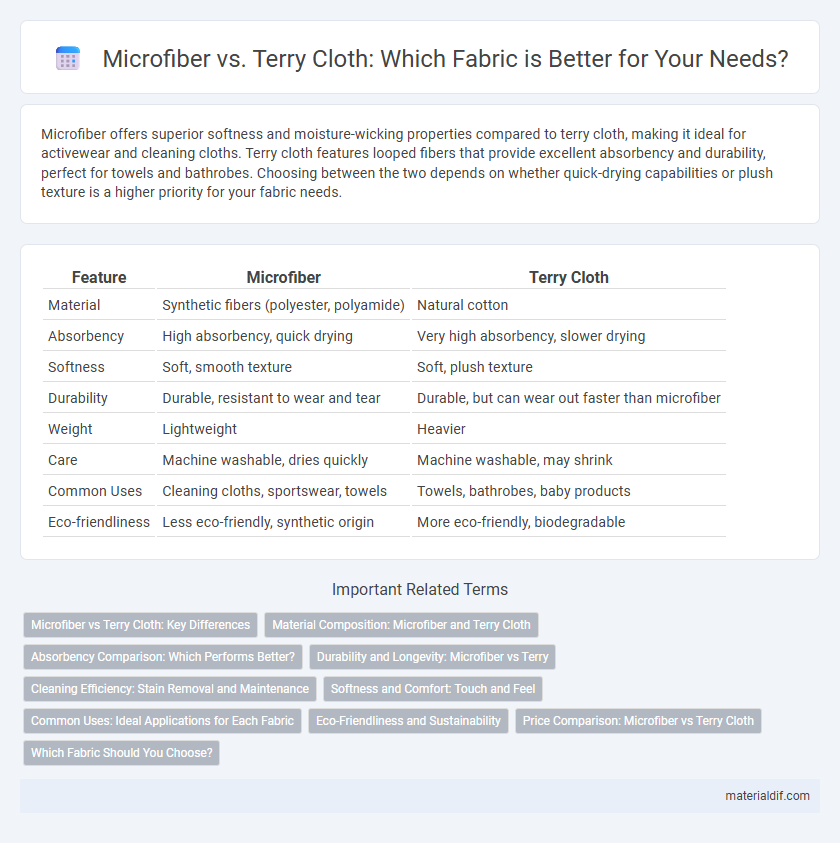Microfiber offers superior softness and moisture-wicking properties compared to terry cloth, making it ideal for activewear and cleaning cloths. Terry cloth features looped fibers that provide excellent absorbency and durability, perfect for towels and bathrobes. Choosing between the two depends on whether quick-drying capabilities or plush texture is a higher priority for your fabric needs.
Table of Comparison
| Feature | Microfiber | Terry Cloth |
|---|---|---|
| Material | Synthetic fibers (polyester, polyamide) | Natural cotton |
| Absorbency | High absorbency, quick drying | Very high absorbency, slower drying |
| Softness | Soft, smooth texture | Soft, plush texture |
| Durability | Durable, resistant to wear and tear | Durable, but can wear out faster than microfiber |
| Weight | Lightweight | Heavier |
| Care | Machine washable, dries quickly | Machine washable, may shrink |
| Common Uses | Cleaning cloths, sportswear, towels | Towels, bathrobes, baby products |
| Eco-friendliness | Less eco-friendly, synthetic origin | More eco-friendly, biodegradable |
Microfiber vs Terry Cloth: Key Differences
Microfiber fabric consists of ultra-fine synthetic fibers, typically polyester or nylon, offering superior absorbency and quick-drying properties compared to terry cloth, which is made from looped cotton fibers providing a plush texture and durability. Microfiber's tightly woven structure makes it highly effective in trapping dust and moisture, ideal for cleaning and sportswear, while terry cloth excels in softness and breathability, commonly used in towels and bathrobes. The choice between microfiber and terry cloth depends on the intended use, with microfiber favored for lightweight, moisture-wicking applications and terry cloth preferred for comfort and absorbency in everyday textiles.
Material Composition: Microfiber and Terry Cloth
Microfiber is made from ultra-fine synthetic fibers, typically polyester and polyamide, which offer high absorbency and quick drying properties. Terry cloth consists of cotton loops woven into the fabric, providing excellent moisture retention and a soft, plush texture. The synthetic nature of microfiber enhances durability and stain resistance, while terry cloth's natural cotton fibers prioritize breathability and comfort.
Absorbency Comparison: Which Performs Better?
Microfiber fabric outperforms terry cloth in absorbency due to its finer fibers that create a larger surface area, allowing it to soak up water quickly and hold up to seven times its weight in liquid. Terry cloth, with its looped cotton fibers, offers substantial absorbency but absorbs moisture more slowly and retains less water overall. For applications requiring rapid drying and maximum liquid retention, microfiber is the more efficient choice.
Durability and Longevity: Microfiber vs Terry
Microfiber fabric exhibits superior durability due to its tightly woven synthetic fibers, resisting wear and tear longer than terry cloth, which consists of looped cotton fibers that can fray over time. Microfiber retains its structural integrity and color through frequent washing cycles, extending the longevity of products like cleaning cloths and towels. Terry cloth, while soft and highly absorbent, tends to experience faster degradation with repeated use and laundering, making microfiber a more resilient choice for long-term applications.
Cleaning Efficiency: Stain Removal and Maintenance
Microfiber excels in cleaning efficiency due to its fine fibers that trap dirt and absorb liquids faster than terry cloth, making it highly effective for stain removal. Terry cloth, with its looped cotton design, provides durability and absorbency but often requires more effort and multiple washes to remove stubborn stains completely. Maintenance of microfiber involves gentle washing to preserve fiber integrity, whereas terry cloth can withstand heavier washing cycles but may lose softness over time.
Softness and Comfort: Touch and Feel
Microfiber fabric offers exceptional softness and a smooth, silky texture that feels gentle against the skin, making it ideal for sensitive skin and luxurious comfort. Terry cloth, known for its looped pile surface, provides a plush and absorbent feel, giving a cozy and cushioned touch perfect for towels and bathrobes. The choice between microfiber and terry cloth depends on preference for silky softness versus thick, cushioned comfort.
Common Uses: Ideal Applications for Each Fabric
Microfiber excels in activewear, cleaning cloths, and upholstery due to its moisture-wicking and quick-drying properties, making it ideal for sportswear and household cleaning. Terry cloth, known for its absorbency and softness, is commonly used in towels, bathrobes, and baby products where comfort and water absorption are essential. Both fabrics serve specific purposes: microfiber for performance and durability, terry cloth for absorbency and comfort.
Eco-Friendliness and Sustainability
Microfiber fabric is made from synthetic materials like polyester and nylon, often derived from non-renewable petroleum resources, which raises concerns about its environmental impact and microplastic pollution. Terry cloth, typically produced from natural fibers such as organic cotton, offers a more sustainable option due to its biodegradability and lower chemical processing requirements. Choosing terry cloth supports eco-friendly practices by reducing landfill waste and promoting renewable resource use, making it a preferable fabric for sustainability-conscious consumers.
Price Comparison: Microfiber vs Terry Cloth
Microfiber fabrics generally cost more than terry cloth due to their complex manufacturing processes and superior absorbency characteristics. Terry cloth, known for its looped texture and durability, tends to be more affordable and widely available, making it a popular choice for budget-conscious consumers. Price differences can vary based on brand, quality, and specific fabric blends, with microfiber often commanding higher prices in both home textiles and apparel markets.
Which Fabric Should You Choose?
Microfiber fabric offers superior moisture-wicking and quick-drying properties, making it ideal for activewear and travel towels. Terry cloth excels in absorbency and softness, perfect for bathrobes and towels used in home settings. Choosing between microfiber and terry cloth depends on your need for durability and drying speed versus plush comfort and maximum water absorption.
microfiber vs terry cloth Infographic

 materialdif.com
materialdif.com